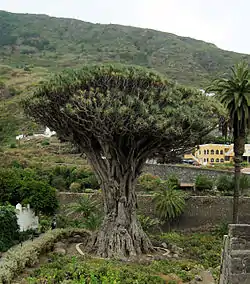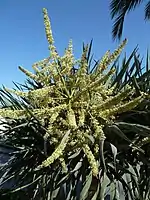Dracaena draco
Dracaena draco, the Canary Islands dragon tree or drago,[3] is a subtropical tree in the genus Dracaena, native to the Canary Islands, Cape Verde, Madeira, western Morocco, and is thought to be introduced in the Azores.[4] It is the natural symbol of the island of Tenerife, together with the blue chaffinch.[5] Its closest living relative is the dragon's blood tree of Socotra, Dracaena cinnabari.[1]
| Dracaena draco | |
|---|---|
 | |
| The ancient specimen El Drago Milenario at Icod de los Vinos, Tenerife (Canary Islands, Spain) | |
| Scientific classification | |
| Kingdom: | Plantae |
| Clade: | Tracheophytes |
| Clade: | Angiosperms |
| Clade: | Monocots |
| Order: | Asparagales |
| Family: | Asparagaceae |
| Subfamily: | Nolinoideae |
| Genus: | Dracaena |
| Species: | D. draco |
| Binomial name | |
| Dracaena draco | |
| Synonyms | |
| |
Description

Dracaena draco is an evergreen long lived tree with up to 15 m (49 ft) or more in height and a trunk 5 m (16 ft) or more in circunference, starting with a smooth bark that evolves to a more rough texture as it ages.[6] Monocot, with a branching growth pattern currently placed in the asparagus family (Asparagaceae, subfamily Nolinoidae).[7] When young it has a single stem. At about 10–15 years of age the stem stops growing and produces a first flower spike with white, lily-like perfumed flowers, followed by coral berries. Soon a crown of terminal buds appears and the plant starts branching. Each branch grows for about 10–15 years and re-branches, so a mature plant has an umbrella-like habit. It grows slowly, requiring about ten years to reach 1.2 metres (4 ft) in height but can grow much faster.[8]
Being a monocotyledon, it does not display any annual or growth rings so the age of the tree can only be estimated by the number of branching points before reaching the canopy. There is considerable genetic variation within the Canary Island dragon trees. The form found on Gran Canaria is now treated as a separate species, Dracaena tamaranae, based on differences in flower structure. The form endemic to La Palma initially branches very low with numerous, nearly vertical branches arranged fastigiately. There is a forest of such trees at Las Tricias, Garafia district, La Palma.[9][10]
Subspecies:
Distribution and habitat

Dracaena draco is native to Macaronesia and southwest Morocco, where it is commonly cultivated as an ornamental plant. On the European Macaronesia, wild endemic populations today are only known in Tenerife and Madeira after recently going extinct in the wild in Gran Canaria. Wild populations in Morocco extend to the southwest Atlas Mountains. Its origin on the Azores is uncertain but it is thought to result from an introduction made by the Portuguese prior to 1500 with seeds from Madeira and Cape Verde, as some individuals were observed to have similarities with the Cape Verdean subspecies (subsp. caboverdeana); there are around 200-300 individuals on remote sites in the island of São Jorge and a few more on other islands and is unknown if these populations can be considered native or the result of an early introduction.[4][14]
Uses

When the bark or leaves are cut they secrete a reddish resin, one of several sources of substances known as dragon's blood. Red resins from this tree contain many mono- and dimeric flavans that contribute to the red color of the resins.[15] Dragon's blood has a number of traditional medical uses, although dragon's blood obtained from Dracaena draco was not known until the 15th century,[16] and analyses suggest that most dragon's blood used in art was obtained from species of the genus Daemonorops.[17] The primary and secondary plant body are the site of the secretory plant tissues that form dragon's blood. These tissues include ground parenchyma cells and cortex cells.[18] Dragon's blood from Dracaena draco and Dracaena cinnabari can be distinguished by differences in 10 compounds and a dominant flavonoid DrC11 missing in Dracaena draco.[17]
The Guanches worshiped a specimen in Tenerife, and hollowed its trunk into a small sanctuary. Humboldt saw it at the time of his visit. It was 70 feet (21 m) tall and 45 feet (14 m) in circumference, and was estimated to be 6000 years old. It was destroyed by a storm in 1868.[19]
Cultivation

Dracaena draco is cultivated and widely available as an ornamental tree for parks, gardens, and drought tolerant water conserving sustainable landscape projects. It has gained the Royal Horticultural Society's Award of Garden Merit.[20][21]
Notable trees
The specimen called "El Drago Milenario" (the thousand-year-old dragon) growing at Icod de los Vinos in northwest Tenerife is the oldest living plant of this species. Its age was estimated in 1975 to be around 250 years, with a maximum of 365 years, not several thousand as had previously been claimed.[22] It is also the largest D. draco tree alive. Its massive trunk comes from the contribution of clusters of aerial roots that emerge from the bases of lowest branches and grow down to the soil. Descending along the trunk, they cling tightly to the trunk, integrate with it and contribute to its radial growth.[23]
The Museum of Wine on Pico Island, Azores, has one of the largest concentrations of this species in Macaronesia, some with more than 100 years old.[24]
References
- Bañares, A.; et al. (1998). "Dracaena draco". IUCN Red List of Threatened Species. 1998: e.T30394A9535771. doi:10.2305/IUCN.UK.1998.RLTS.T30394A9535771.en.
- "Dracaena draco", World Checklist of Selected Plant Families, Royal Botanic Gardens, Kew, retrieved 2013-11-12
- "Forest 15 - Dragon Tree", National Arboretum Canberra, Australian Government, retrieved 2018-09-22
- Almeida Pérez, R.S. & Beech, E. (2017). "Dracaena draco". IUCN Red List of Threatened Species. 2017: e.T30394A103368016.CS1 maint: multiple names: authors list (link)
- "BOC - 1991/061. Viernes 10 de Mayo de 1991 - 577". www.gobcan.es.
- "Dracaena draco (L.) L." University of Madeira. Retrieved 13 January 2021.
- Chase, M.W.; Reveal, J.L. & Fay, M.F. (2009), "A subfamilial classification for the expanded asparagalean families Amaryllidaceae, Asparagaceae and Xanthorrhoeaceae", Botanical Journal of the Linnean Society, 161 (2): 132–136, doi:10.1111/j.1095-8339.2009.00999.x
- Dracaena Draco Farm, retrieved 2011-11-03
- "Dracaena draco". www.floradecanarias.com.
- "Buracas - Visit La Palma". visitlapalma.es.
- "Dracaena draco subsp. draco". Catalogue of Life. Retrieved 13 January 2021.
- "Dracaena draco subsp. ajgal Benabid & Cuzin". Catalogue of Life. Retrieved 13 January 2021.
- Rodríguez, Pérez. "A new subspecies, Dracaena draco (L.) L. subsp. caboverdeana Marrero Rodr. & R.S. Almeida (Dracaenaceae) from Cape Verde Islands". A new subspecies, Dracaena draco (L.) L. subsp. caboverdeana Marrero Rodr. & R.S. Almeida (Dracaenaceae) from Cape Verde Islands. Retrieved 13 January 2021.
- "Dracaena draco subsp. draco". Flora-on. Retrieved 13 January 2021.
- Porter, Lawrence J. (1988-01-01). "Flavans and proanthocyanidins". In Harborne, J. B. (ed.). The Flavonoids. Springer US. pp. 21–62. doi:10.1007/978-1-4899-2913-6_2. ISBN 9780412287701.
- Gupta, D.; Bleakley, B.; Gupta, R.K. (2007). "Dragon's blood: Botany, chemistry and therapeutic uses". Journal of Ethnopharmacology. 115 (3): 361–380. doi:10.1016/j.jep.2007.10.018. PMID 18060708. Retrieved 2015-02-17.
- Baumer, Ursula; Dietemann, Patrick (2010-06-01). "Identification and differentiation of dragon's blood in works of art using gas chromatography/mass spectrometry". Analytical and Bioanalytical Chemistry. 397 (3): 1363–1376. doi:10.1007/s00216-010-3620-0. ISSN 1618-2642. PMID 20349349. S2CID 13267387.
- Jura-Morawiec, Joanna; Tulik, Mirela (2015-05-01). "Morpho-anatomical basis of dragon's blood secretion in Dracaena draco stem". Flora - Morphology, Distribution, Functional Ecology of Plants. 213: 1–5. doi:10.1016/j.flora.2015.03.003.
- Gilman, D. C.; Peck, H. T.; Colby, F. M., eds. (1905). . New International Encyclopedia (1st ed.). New York: Dodd, Mead.
- "RHS Plant Selector - Dracaena draco". Retrieved 1 June 2020.
- "AGM Plants - Ornamental" (PDF). Royal Horticultural Society. July 2017. p. 33. Retrieved 6 February 2018.
- Magdefrau, K. (1975), "Das Alter der Drachenbaume auf Tenerife", Flora, 164 (4–5): 347–357, doi:10.1016/S0367-2530(17)31807-8
- Krawczyszyn, J.; Krawczyszyn, T. (2014). "Massive aerial roots affect growth and form of Dracaedna draco". Trees Structure and Function. 28 (3): 757–768. doi:10.1007/s00468-014-0987-0.
- "Mata de Dragoeiros". Pico Museums. Retrieved 13 January 2021.
Bibliography
| Wikimedia Commons has media related to Dracaena draco. |
- Arkive: Dracaena draco factsheet.
- Dracaena draco in Morocco(photo gallery).
- The climate requirements for Dracaena draco defined by its borders: Northernmost tree in the world, near 40°, northern Azores Islands and Southernmost dragon tree in the world, near 38°, Victoria, Australia (photos).
- Benabid, A. & Cuzin, F. (1997). Dragon tree (Dracaena draco subsp. ajgal Benabid et Cuzin) populations in Morocco: Taxonomical, biogeographical and phytosociological values. Comptes Rendus de l'Académie des Sciences Série III Sciences de la Vie 320(3): 267–277.

.jpg.webp)